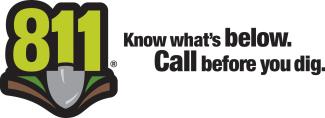Rhode Island DigSafe
Before you start your project, get in touch with Dig Safe Inc., a nonprofit organization that will notify your utility company about your project for free. Then, your utility company will help you plan a safe dig.
April is Safe Digging Month - Gubernatorial Proclamation
You can contact Dig Safe by dialing 811 or (888) 344-7233.
- Incident Report to DPUC - (Fillable NOPV Form)
- Dig Safe Probable Violations & Damage Prevention Program Statistics
Dig Safe Law:
RIGL §39-1.2 "Excavation Near Underground Utility Facilities"
Dig Safe Law Amendments in 2024
RIGL 39-1.2-1
Definition of: "Damage" expanded
(5) “Damage” means and includes, but is not limited to, the substantial weakening of structural or lateral support of a utility line; penetration or destruction of any utility line protective coating, housing, or other protective device; or the severance, partial or complete, of any utility line. Notwithstanding the foregoing, damage shall not include an intentional penetration or severance of a utility line by a public utility or its contractor(s) for the purpose of effectuating a repair or replacement of the utility line
RIGL 39 1.2-11
Clarification of 911 notification requirement.
Upon the occurrence of a serious electrical short, or the unanticipated release of any federal Pipeline and Hazardous Materials Safety Administration (PHMSA) regulated natural or other gas or hazardous liquid from a damaged pipeline, the person or public agency responsible for the operations causing the damage shall promptly report the release to first responders by calling 9-1-1. In the event of an immediate danger to life and health occurrence, the area shall be evacuated until proper emergency services arrive
Dig Safe Law Amendments in 2017
Significant Provisions - Legislation
Provision Eliminated: (a) Except as provided in § 39-1.2-9, any person, public agency, or public utility 30 responsible for excavating within one hundred feet (100') or for discharging explosives within one hundred feet (100') of a public utility facility shall notify the association of the proposed excavation or discharge at least seventy-two (72) hours, excluding Saturdays, Sundays, and holidays, but not more than thirty (30) days before commencing the excavation or discharge of explosives. Actual excavation must thereupon commence within thirty (30) days. Each public utility shall, upon receipt of each notice of excavation, mark within seventy-two (72) hours or, where applicable in accordance with § 39-1.2-12, re-mark within forty-eight (48) hours, the location of all underground facilities
Includes a requirement to "call 911 if the damage presents an immediate danger to life and health of employees or pedestrians in the surrounding area. In the event of an immediate danger to life and health occurrence, the area shall be evacuated until proper emergency services arrive."
Dig Safe Laws were amended in Rhode Island in 2014
Two provisions were changed, §39-1.2-5. Notice of excavation and §39-1.2-11. Damage--Notice to public utility
The changes require excavators to provide the Dig Safe association with more specific information, such as the nearest numbered building address, when describing or defining the excavation/worksite location.
The changes include the requirement that the Division be notified when underground facilities of a public utility or any pipe, cable or its protective coating have been damaged. Similar reporting requirements exist in Massachusetts.
Finally, removing the reference to “telephone” simply allows for the association to be contacted by whatever electronic means is appropriate. The reference to “telephone” communications is obsolete since a large volume of “Dig Safe tickets” are now obtained through e-mails.
Dig Safe Laws incorporated significant changes that were effective November 1, 2009
Changes include marking, notice and penalty provisions. (Legislation with changes)
If you are planning an excavation project, call Dig Safe at 811 or visit digsafe,

Other Resources and Helpful links
